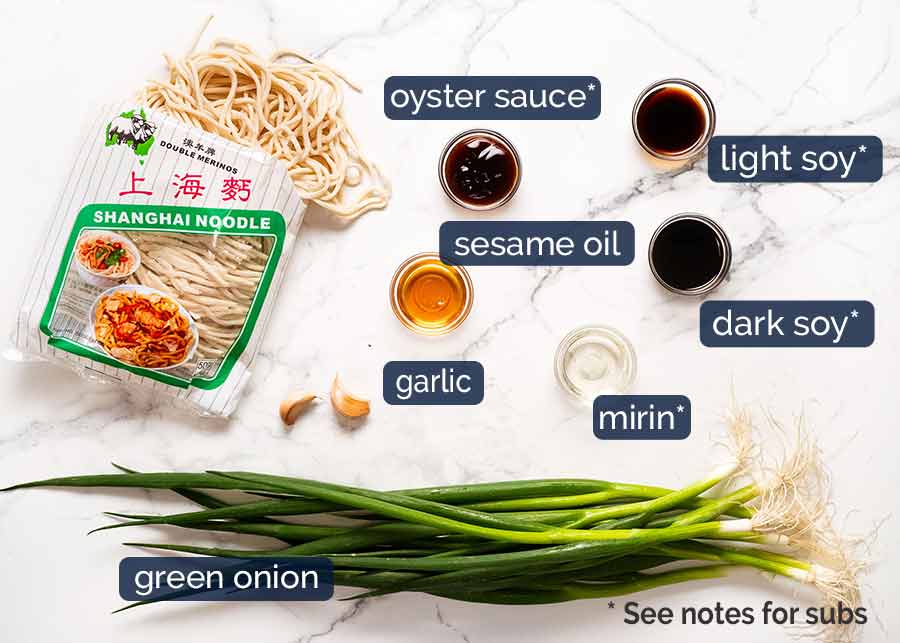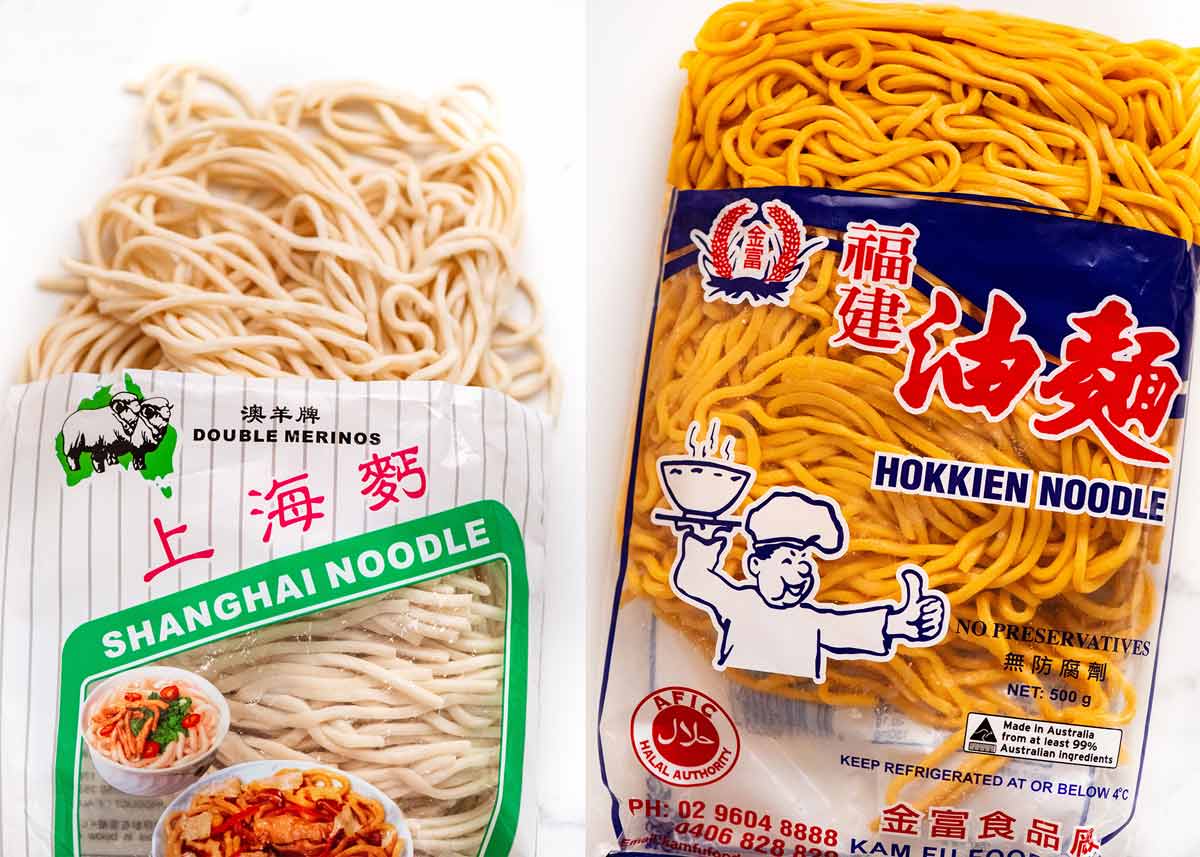[ad_1]
These tasty noodles might be simple but I make them a LOT! Perfect for all those times you’re scrambling for a quick side dish for Asian foods and want something more interesting than plain rice. Flavoured enough to devour as-is, neutral enough to serve alongside main dishes. Supremely easy, supremely tasty – Supreme Soy Noodles!

After a 6 month hiatus to focus on my debut cookbook, I’m back with a brand new recipe! I’m easing in here with something super quick and easy, but something you’ll make over and over again…. Hope you love it as much as I do! ~ Nagi x
Supreme Soy Noodles – the Asian noodles for everything!
My first new recipe in 6 months!!! Simple and fast, Supreme Soy Noodles are THE Asian noodles to serve with everything and anything Asian. These are fast to make and flavoured enough to eat plain, despite the absence of loads of add-ins. Yet they’re also neutral enough to partner with any mains. Well, Asian mains – like Chinese BBQ Pork, Sticky Asians Wings, Chicken or Beef Satay Skewers, Korean Pulled Pork …
But hey, if you even want them alongside your Sunday roast chicken, who am I to judge!! 😂
If you’re wondering about the rather grandiose name “Supreme Soy Noodles” I’ve given such a simple dish … well, the truth is, it is partly in jest to amuse myself. 😂 (I am easily amused). I love the colourful, superlative names Chinese restaurants often give their dishes. So here’s mine inspired by this dish, and I’m going to stand by it. Because simple it may be, but it’s got teeth! If you try it, tell me if you agree!!

What you need to make these soy noodles
The sauce for these noodles is based around soy sauce. But here’s the thing – you can’t use only soy for a good noodle sauce! Soy-only sauces are one-dimensional and bland. Instead we’re also using a handful of staple Asian sauces here to add depth and character. Ready-to-use sauces like these also minimises the list of ingredients while still delivering big on flavour!
Here’s what you need:

You can’t just use soy sauce! It’s too bland!
-
Soy sauces – The dominant flavour in this sauce, I’m using a combination of dark and light soy sauce here. Together they deliver the flavour and colour I am aiming for. Dark soy sauce has a more intense flavour and stains the noodles a beautiful mahogany colour you can see in the photo below. The light soy sauce adds extra savour without too much colour so the sauce doesn’t get too dark. See recipe notes for how to switch these out, and more on different soy sauces here!


-
Oyster sauce – Sweet, salty, thick and pungent, oyster sauce is one of the secret ingredients in this recipe. Oyster sauce punches high above its weight when it comes to adding incomparable complexity, flavour and umami all at once to any dish you add a few dashes of the stuff to. A staple sauce in Chinese and South-east Asian cooking, it’s made from oyster extract which gives it that intensely savoury flavour. However it doesn’t tasty oyster-y (is that a word??) or fishy at all. See recipe notes for substitutes.
-
Mirin – This is a sweet Japanese cooking wine that is the other secret ingredient that brings flavour and nuance to this dish. Typically in Chinese recipes you’d see Chinese cooking wine used with a touch of sugar added when needed. But today, I’m taking a shortcut by using mirin which already has sugar in it. One less ingredient needed! Non-alcoholic substitute – Use more oyster sauce.
-
Sesame oil – Toasted (ie brown-hued) as opposed to un-toasted (yellow-hued, with less sesame flavour). Here in Australia, toasted sesame oil is the norm. It’s actually hard to find un-toasted. Note the sesame oil is added to the sauce and not used for as frying fat, because it loses flavour the longer it’s cooked.
-
Green onion – Serving dual functions here. One, as an aromatic flavour base when we sauté the white part with the garlic to flavour the oil. Later, the green parts are used to add a touch of colour and bite throughout the noodles.
-
Garlic – You’ll be pressed to find a recipe on this website that doesn’t include garlic (well, maybe a cake recipe or two. 😂)

-
Noodles – Use any noodles you want – white or yellow, thick or thin, dried or fresh. I used fresh white noodles (from the fridge section of my shop) which I generally prefer over dried noodles. I like the texture better, it’s chewier and also has better flavour. Having said that, this recipe will work just fine with dried noodles too. Or even spaghetti. Yes, there, I said it! It sounds so wrong, but dried spaghetti is just flour and water, same as many dried noodles. So once it’s tossed with the sauce, you really can’t tell the difference!!
How to make Supreme Soy Noodles
It’s a 4-minute cook. There should be more recipes in the world like this amirite 😂

Make sure you have all the ingredients chopped and ready to go because once you start cooking, things move quickly! These noodles only take 3 minutes!
-
Sauce – Mix the sauce.
-
Green onion – Cut up the green onion, separating the darker green part from the firmer white and pale green parts. We’re going to cook the white part first as they take longer to cook. The green part only needs to be tossed in at the very end as it wilts in seconds.
-
Cook noodles per the packet directions. Some tips:
– Cook noodles just before you start stir frying. Don’t leave cooked, drained noodles laying around before stir frying as it makes them more prone to breaking or sticking to each other.
– Use plenty of boiling water so the noodles cook evenly and loosen.
– Rinse the noodles briefly after draining so they don’t end up sticking together in a gluey block. -
Sauté aromatics – Using either a wok or large non-stick pan over high heat, heat the oil until very hot. Then we start by cooking the white and pale green part of the green onion for around 20 seconds to give them a head start as well as flavouring the oil. Then, toss the garlic in and cook for around 10 seconds just until lightly golden. Don’t let the garlic burn – it goes bitter!

-
Noodles and sauce – Add the noodles and sauce then toss for around 1 1/2 minutes until all the noodles are evenly coated in the sauce and you start to see some of the noodles caramelising a bit. It might take a bit longer depending on the strength of your stove.
Don’t skip the caramelisation step! It adds such great flavour to the noodles!
-
Green onion – Lastly, add the green part of the green onions then toss for 30 seconds just until wilted. That’s it, you’re done! Ready to serve!
To serve, either transfer all the noodles into a large serving dish and let everyone serve themselves, or divide between individual serving plates.
Garnishes – I don’t use any garnishes here so it can be served as a side dish. But if you want to pretty it up, a sprinkle of finely sliced green onion or sesame seeds (or both!) wouldn’t go astray.


What to serve with these Asian noodles
I originally created these noodles to round out a full meal consisting of Chinese dumplings (Potstickers) plus a side of steamed Asian Greens with Oyster Sauce, with Chinese corn soup to start (I skipped the chicken in the soup).
Dumplings and noodles for dinner!
But as I’ve already mentioned too many times above (😂), the beauty of these Asian noodles is they are multipurpose. They are plain enough to serve alongside any full flavoured Asian mains – like Chinese BBQ Pork (Char Siu) – as a carby filler. But they’re also well-flavoured enough to eat on their own as a fast and simple meal. And boy have I inhaled many bowls of these noodles!! Here are some suggestions for other mains to serve with these:
Mains to serve with these noodles
“Can I add more vegetables and proteins?”
For add-ins like protein and vegetables, this recipe will work with a small amount of extras like some shredded carrot. However you don’t want to add too much bulk else it will dilute the flavour. I’d actually recommend using my Lo Mein noodles recipe instead if you want a more complete noodle dish. It has a similar-tasting sauce but is purpose-built specifically for a larger volume of add-ins (by way of more sauce thickened with cornflour/cornstarch so it coats the veg etc).
~~~~~~
And there you have it! The first new recipe I’ve put up for over 6 months, I hope you enjoy it! I plan to publish a new recipe each week for the foreseeable future while I wrap up the cookbook (catch up on updates here!) and also kick off some exciting new changes happening in the world of RecipeTin … stay tuned!! – Nagi x
Watch how to make it
Hungry for more? Subscribe to my newsletter and follow along on Facebook, Pinterest and Instagram for all of the latest updates.

Supreme Soy Noodles
Prep: 5 mins
Cook: 5 mins
Noodles, Side Dish
Asian, Chinese
Servings4 – 5 as side
Tap or hover to scale
Instructions
-
Mix Sauce ingredients in a small bowl.
-
Cook noodles per packet directions (see cooking tip in Notes). Drain and give it a quick rinse under tap water to stop them sticking together as they sit.
-
Sauté garlic – Heat oil in a large deep non-stick skillet or wok over high heat. Add white part of green onions, stir for 20 seconds. Add garlic and stir for 10 seconds or until light golden.
-
Add noodles, sauce – Add noodles then pour over Sauce. Toss for 1 1/2 minutes. Don’t skimp on this step, the flavour is so much better when the noodles caramelise slightly. If your stove is a bit weak, you might need to go longer!
-
Green onions – Add green onion and toss until just wilted, about 20 seconds. Serve immediately.
Recipe Notes:
If using dried noodles (egg noodles, rice noodles, ramen noodles, even spaghetti!) – use 200g / 7 oz uncooked weight (once cooked, it will be around 500g / 1l b).
2. Soy sauce subs – Light soy sauce can be substitute with all-purpose soy sauce. Dark soy gives the noodles colour and flavour. It can be substituted for more light soy sauce and will still be tasty, but noodles won’t be as dark and slightly less intense in flavour. See here for more info on different soy types and subs.
3. Oyster sauce provides flavour and sweetness, don’t skip it. Subs: These days you can get even vegetarian oyster sauce, even at some large grocery stores! Hoisin is an acceptable sub though it adds a five spice flavour (still tasty, just different!)
4. Mirin – Substitute with Chinese cooking wine OR dry sherry + 1 tsp white sugar (mirin is sweeter). For non-alcoholic, substitute with 1 tbsp extra oyster sauce.
5. Leftovers will keep for 4 to 5 days in the fridge. Freezing not recommended.
TIP: Cooking noodles
Cook the noodles per the packet directions. Some require only soaking, most require boiling. For boiled noodles, start the timer when you first drop the noodles into the boiling water, not from when it comes back up to the boil. Loosen noodles as they cook with tongs or chopsticks. Rinse under cold tap water so they don’t clump into an unworkable block as they cool, and shake off excess water before using.
Nutrition Information:
Calories: 315cal (16%)Carbohydrates: 45g (15%)Protein: 8g (16%)Fat: 12g (18%)Saturated Fat: 2g (13%)Polyunsaturated Fat: 3gMonounsaturated Fat: 5gTrans Fat: 1gSodium: 791mg (34%)Potassium: 91mg (3%)Fiber: 3g (13%)Sugar: 3g (3%)Vitamin A: 239IU (5%)Vitamin C: 5mg (6%)Calcium: 23mg (2%)Iron: 3mg (17%)
Life of Dozer
Just as cute as ever. ❤️ For a more comprehensive catch up on Life of Dozer, see the last cookbook update!

[ad_2]
Source link





More Stories
The Gateway to Yosemite is More Than Just a Gateway
Sweet Potato Brownies – Downshiftology
Movie Night and Smart TV Instant Win • Steamy Kitchen Recipes Giveaways